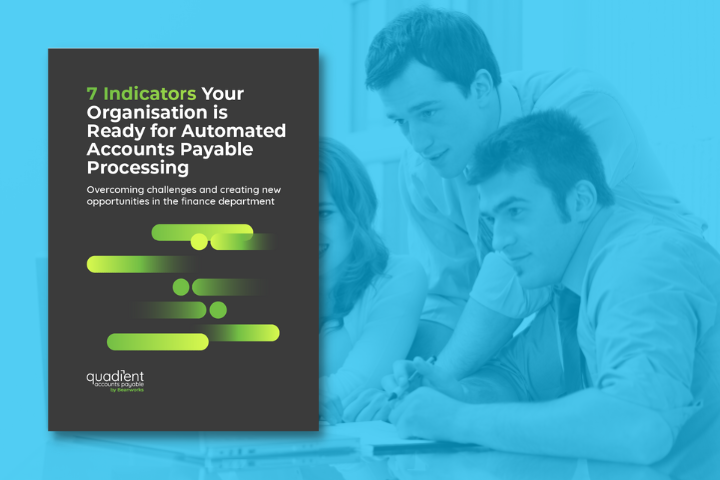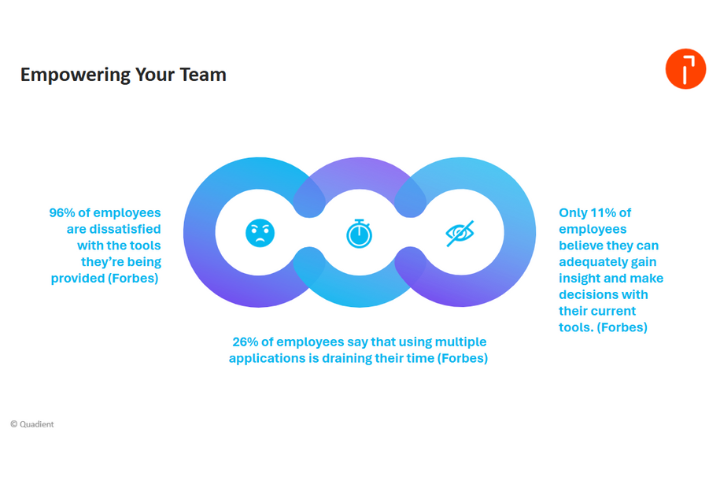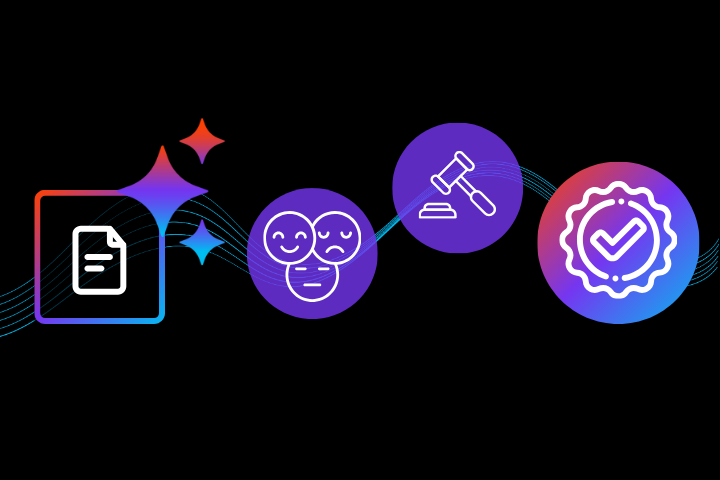
Introduction
Automating your AP is not something you can put off till next year.
It needs to happen now.
The reasons are many. For one, manual invoice processing is wasting your money. Studies put the cost at £15 per invoice — at least — and as high as £40. But the pain inflicted by outmoded manual processes goes much beyond your per-invoice bottom line, negatively affecting everything from supplier relations and employee morale to data processing and future forecasting.
If your organisation is still using time-consuming manual and paper-based processes for AP, you’ve likely experienced some of the same frustrations that have motivated many organisations to switch to intelligent machine-learning backed systems.
In a recent EY survey (2020), 41% of respondents said investing in automation is a key priority. The benefits of automation are clear: from cost savings to fraud prevention, processes that leverage artificial intelligence (AI) and machine learning (ML) are proving to be essential differentiators for the world’s top performing organisations. At the bare minimum, integrating automated finance processes into your workflows — and customising them for your specific needs — can increase productivity for your finance team and make their work more efficient. It will also give your entire organisation greater insight into your finances. This, in turn, informs smarter decisions, empowering the CFO to have a great role in strategic decisions that will guide your organisation forward.
Automation can be easily integrated to your processes — and it’s easier to do than you may think. Quadient Accounts Payable by Beanworks integrates seamlessly with your accounting system.
In this guide, we will explore how AP automation can:
Bring any organisation’s workflows to the next level,
Increase productivity for your finance team,
Improve your bottom line, and
Give your organisation a competitive advantage.
Indicator 1: Supply Issues Arise When Suppliers Aren’t Onboard
The success of your business relies on timely, reliable, and quality inputs of materials and services from suppliers. Customers are counting on you.
But, if the right suppliers aren’t approved in time, production or projects can grind to a halt. Or if a supplier throws up their hands in frustration when forced to endure a cumbersome, slow, and analog onboarding process, they might just find work elsewhere.
Every company must invest in procuring raw materials, consumables, machinery, and equipment. This can involve a vast supplier and vendor network. These relationships are key to your future — and they are tenuous. If invoices aren’t paid according to previously agreed terms, suppliers can become frustrated. This jeopardises everything, from inventory levels to project launch.
If a vendor is spooked by indications that your payments are falling behind, they may shorten payment terms or lower the levels of supply or service. Quality standards may slip.
This may negatively impact your organisation’s ability to launch a new project as planned — and the snowball effect could create even more obstacles down the road. At worst you may lose a vendor or supplier to another company that offers quicker onboarding due to modernised systems.
Inefficient AP can ruin your reputation and destroy your business. Maintaining positive and mutually beneficial relationships with suppliers is key.
HERE’S HOW AUTOMATED AP FORGES STRONGER VENDOR AND SUPPLIER RELATIONS:
Faster payments
Significantly speed up payment processing times, ensuring you deliver on all terms and agreements. This helps vendors manage their cash flow and reduces the likelihood of disputes.
Accurate payments
Eliminating manual errors such as duplicate payments, incorrect amounts, and missed payments builds trust and confidence with vendors.
Improved communication
Vendors and suppliers can receive real-time updates on the status of their payments, including confirmation when payments are processed and when they are scheduled to be paid.
Dispute resolution
With all records maintained in a digital vault, resolution can be quickly achieved by providing a clear and auditable record of all transactions.
Indicator 2: Late Penalties are Charged on Overdue Invoices
When the heavy work of running a business is the main priority, mundane tasks like invoice tracking and approval can fall by the wayside. Invoices can languish during the approval process. They can get lost. Or the one person who needs to sign off is unavailable. This pressure leads to staff burnout and revenue lost — and you’re paying extra.
When you switch to automated processing, you won’t miss any due dates, and approvals can be obtained remotely. This reduces pressure on your team and ensures cash flow is fully tracked. Even better, with full visibility into invoice status at every stage, you can take advantage of discounts for early payment.
AN AUTOMATED AP PROCESS CAN HELP REDUCE LATE PENALTIES BY:
Enhancing visibility
Customisable dashboards and reporting tools provide visibility into invoice status and payment history on your terms.
Streamlining invoice processing
Automation reduces the manual efforts and time spent on paperbased invoice processing. This leads to faster invoice processing and lower processing costs.
Early payment discounts
Automation helps organisations take advantage of early payment discounts by streamlining invoice processing and payment workflows.
Better cash management
With real-time visibility into cash flows and payment cycles, organisations can optimise payment timing and cash management. This can reduce fees due to late payments, overdrafts, and other cash-management issues.
Indicator 3: You’re Noticing Signs of Fraud but Lack Controls to Trace it
Fraud is a serious issue in organisations around the world and the pandemic only exacerbated the problem. In 2018, companies worldwide lost more than £7 billion due to fraud.
In the absence of efficient and automated audit solutions, vulnerability to AP fraud is a serious possibility — and could result in hefty monetary losses. The higher the degree of manual processes within your accounting department, the greater the chance of payment fraud going undetected. The reliance on paper and manual systems is one of the primary problems — for example, paper approval routing and the issuing of check payments.
People used to think that paper is more secure — not anymore. In fact, it is easier to tamper with paper records. Check endorsements can be forged and approvals fabricated. Duplicate invoices can be “slipped” into the mix.
And when it comes to audits and investigations, fraud is harder to detect within a manual processing operation. Paper can go missing.
Automated systems powered by AI and ML can greatly reduce this exposure by identifying duplicate invoices and suspicious activity such as hidden or extra charges, duplicate clients, or fictitious POs.
Risk management software can alert to irregularities, such as repeated contact information or unverified vendors or suppliers. As well, automated approval processes ensure tighter controls and accountability.
From the start of your AP cycle to its conclusion, automated AP can capture, route, code, request approval, and ensure payments get sent to the right supplier in a timely manner. The risk of errors, fraud, and late payments are mitigated and the cost to process a single invoice is significantly reduced.
HERE’S HOW AUTOMATED AP CAN HELP REDUCE YOUR FRAUD RISK:
Invoice verification
An automated AP system uses AI and ML to verify the accuracy of invoices — all details are matched the with the corresponding purchase orders, contracts, and other supporting documents. With these checks in place, only legitimate invoices are processed and paid.
99% accuracy
Invoices are entered into the system with 99% accuracy, which helps your team reduce the scope of human error and save countless hours on reconciliation.
Real-time access to invoices
Printed invoices provide no quick access to data, costing time and money spent filing and looking up paperwork, especially during an audit. Invoices stored digitally can be easily searched for, making internal and external auditing fast and more efficient.
100% visibility
Automated AP allows accounting teams to look up invoice status in real-time, helping alleviate lengthy invoice processing times and late payments. You can set up approval workflows and run reports on them, making it easier to track where an invoice is being held and how long it’s been there.
Approval workflow
An automated approval process, customised for your own specific needs, ensures that every invoice is reviewed and approved by the appropriate personnel before payment.
Segregation of duties
Your approval flow can be customised, with the assignment of duties such as invoice creation, approval, and payment. This ensures that no one person has control over the entire process.
Fraud detection
Data analytics and ML algorithms can detect patterns of fraudulent activity, spotting such things as duplicate invoices, payments to unauthorised vendors, and suspicious invoice details.
Audit trail
With automated AP, you have an audit trail that tracks every step of the invoice and payment process, making it easier to trace any fraudulent activity back to its source.
Indicator 4: Supplier Payments are Late
This is one of the major indicators that you have a problem in AP.
By the time your suppliers complain, the problem is more serious than you may imagine. You could lose those relationships — your supplier might decide it’s not worth the hassle anymore. Or you could face late charges or even litigation.
So, what’s going on? Why is everything late? Possibly, it’s because invoices are stuck in the AP department, either due to approval delays, slow PO matching, or one of the other manual tasks that affects how quickly payments can be sent out the door. But the problems could go deeper. Invoices may be going missing during the shuffle from desk to desk or lost under stacks of paper. Every time that piece of paper moves is an opportunity for something to go wrong. And, at the end of it all, somebody must key in the data and release the money.
AN AUTOMATED AP SYSTEM CAN HELP SUPPLIER RELATIONS BY:
Streamlining invoice processing
With an automated AP process, invoices can be received and processed quickly, reducing the amount of time it takes to approve and pay them.
Eliminating manual errors
Reduce or eliminate manual errors, such as data entry mistakes or misfiling of invoices. This ensures that invoices are processed accurately and in a timely manner, reducing the risk of late payment penalties.
Enforcing payment terms
Compliance with agreed-upon payment terms is assured with automated AP, avoiding late fees and other penalties.
Improving communication
A customised dashboard and notifications settings help deliver clear and timely communication between suppliers and AP teams. Invoices are received and processed in a timely manner. This builds supplier relationships and reduces the risk of late payments due to miscommunication.
Indicator 5: Invoice Issues are Frustrating the Finance Team
These past few years have been challenging for everyone. But specific issues arising from a paper-based AP processing system have been put under a spotlight — and the pain points amplified.
If you lacked a standardised AP process before the pandemic, you really felt it during the lockdown. Even without forced remote work, manual systems were slow and fraught with potential problems, such as poor communication, lack of approval protocols, and potential bottlenecking of workflows. Invoices languishing in inboxes hurt your reputation with customers and your cash flow, impacting your organisation’s financial picture.
Manual processes lead to employee burnout. It’s a serious issue that, according to research, results from mundane tasks — keystroke entry, filing of paper documents, etc. Of the top processes that reduce productivity, paper-based invoicing is among the top three. Reduced productivity leads to dissatisfaction and an employee-retention problem.
Research indicates 55% of finance professionals do not have enough time to complete routine tasks and 63% percent say that their lack of visibility into accounting processes leads to overtime.
So, let’s talk about some good news. After modernising financial management systems, 78% of finance professionals report being able to free up time to focus on high-level tasks — leading to a stronger sense of accomplishment and contribution to their organisations.
THESE ARE SOME OF THE BENEFITS FOR YOUR FINANCE TEAM THAT RESULT FROM AUTOMATION:
Data entry reduced by 83%
Your finance team will spend less time on mundane keystroking and more time on higher-value tasks.
Quickly create digital invoices
Batch scan paper invoices, and easily split them into separate invoices with a simple drag and drop.
Seamless integration
With a customised interface, make expense reports magically transform into invoices that are automatically synced with your accounting software.
Indicator 6: Executives Can’t Get Financial Insight to Make Decisions
When staff spends more time looking for information rather than processing it into useful data and reports, you have a serious imbalance that could jeopardise growth. Outdated systems and loose protocols create information silos that provide poor-tono visibility.
An automated AP system allows accounting teams to look up an invoice’s status in real time, tracking where it is in the cycle and how long it’s been at any one stage. In a digital environment, a global search allows filtering by categories such as vendor, invoice number or amount, with an image of the invoice readily available along with the data. This simplifies and speeds up internal and external auditing and provides you and your team valuable insight into your financials that can help inform critical decisions.
Quick Tip: Calculate how much invoice processing may be costing you.
HERE’S HOW AUTOMATED AP PROVIDES MORE CLARITY ON FINANCES:
Improving visibility and control
An automated AP process provides real-time visibility into invoice status, approval workflows, and payment history. This enables teams to proactively manage the AP process, identify potential errors or issues, and take corrective action and make informed decisions based on an analysis of the data.
Analyse spending
Detailed spend analysis reports help identify trends that may have been invisible previously, providing insight into vendor payments, invoice processing times, and other metrics. With this information, CFOs can identify how to optimise spending and reduce costs.
Cash flow reports
With a few clicks, up-to-the-minute cash flow reports can be viewed, helping to predict future cash flow based on historical data, helping the finance team make informed decisions about budgeting and cash management.
Process efficiency
Reports can be generated analyse efficiency, such as how long it takes to process invoices or how many invoices are processed per day. This can help identify bottlenecks and inefficiencies in the AP process and make data-driven decisions to improve efficiency.
Indicator 7: Manual Data Input is Wasting Time and Causing Mistakes
In today’s digital age, it may be surprising to learn that 57% of businesses are still using manual invoice data entry.
Potential errors aside, manual keying from paper invoices is extra work that costs time and money. Organisations that have converted to automation see savings of 60% to 80% compared to paper-based systems. The goal — and this is achievable — should be to get the average per-invoice cost to £5 or less. For a company processing 500 invoices a month, that can mean a savings of £78,000 in a year.
Though many businesses indicate that moving to automated AP processing is a top priority, it can be hard to make the leap. A serious cost-benefit analysis will show that these processes are perfectly suited to automation that is backed by machine learning (ML) and artificial intelligence (AI). Implementing these processes is also easier than you may think. Think about the upside: intuitive dashboards can be customised to your specifications. You’ll have insight into whatever parameters you need.
All the manual labor — entering invoice data, sorting into specific batches, confirming PO matching, coding, and getting a manager’s approval — is dramatically more accurate and traceable in a digital workflow. This eliminates human errors — such as incorrectly coded line items, manual key-in errors — or bottlenecks due to volume. Managers can approve invoices and expense reports online, no matter their location.
No more data entry errors
Eliminating the need for manual data entry eliminates errors. Instead, invoices are automatically captured and processed, reducing the risk of typos, transposed numbers, or other mistakes. Invoices are entered into the system with 99% accuracy.
Automate invoice matching
Automatically match invoices with purchase orders and receipts, ensuring that the invoice amount matches what was ordered and received. This helps to catch discrepancies or errors before invoices are paid.
Reduce errors from manual routing
By automating approval workflows, invoices are automatically routed to the correct approver and all approvals are obtained. This reduces the risk of delays or errors.
Enhancing data accuracy
Machine learning (ML) and artificial intelligence (AI) technologies extract information from invoices, ensuring data is accurate and consistent.
AN AUTOMATED ACCOUNTS PAYABLE PROCESS CAN REDUCE MISTAKES IN SEVERAL WAYS:
Last Thoughts
The unknown can be intimidating, and legacy processes can be hard to abandon. If your business is experiencing any of the seven indicators discussed above, it’s a sign it may be time to embrace next-level AP technology. The benefits are clear: fewer data entry means less errors and less expenses; faster and more reliable payments to suppliers will help your business attract and retain the best vendors; and the watchful eye of AI and ML technology means the finance team shouldn’t have to worry as much about fraud.
Consider a move to AP automation as the next step in financial management modernisation for your organisation.
Complete the form to download the white paper and take a proactive step towards AP excellence.










